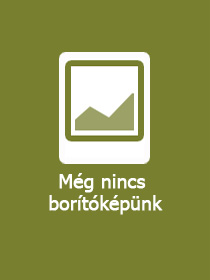
Demonic Bodies and the Dark Ecologies of Early Christian Culture
-
10% KEDVEZMÉNY?
- A kedvezmény csak az 'Értesítés a kedvenc témákról' hírlevelünk címzettjeinek rendeléseire érvényes.
- Kiadói listaár GBP 93.00
-
47 067 Ft (44 826 Ft + 5% áfa)
Az ár azért becsült, mert a rendelés pillanatában nem lehet pontosan tudni, hogy a beérkezéskor milyen lesz a forint árfolyama az adott termék eredeti devizájához képest. Ha a forint romlana, kissé többet, ha javulna, kissé kevesebbet kell majd fizetnie.
- Kedvezmény(ek) 10% (cc. 4 707 Ft off)
- Discounted price 42 361 Ft (40 343 Ft + 5% áfa)
47 067 Ft

Beszerezhetőség
A kiadó fontolgatja a könyv utánnyomását, de bizonytalan, hogy ez mikor következik be.
Why don't you give exact delivery time?
A beszerzés időigényét az eddigi tapasztalatokra alapozva adjuk meg. Azért becsült, mert a terméket külföldről hozzuk be, így a kiadó kiszolgálásának pillanatnyi gyorsaságától is függ. A megadottnál gyorsabb és lassabb szállítás is elképzelhető, de mindent megteszünk, hogy Ön a lehető leghamarabb jusson hozzá a termékhez.
A termék adatai:
- Kiadó OUP USA
- Megjelenés dátuma 2022. július 11.
- ISBN 9780197581162
- Kötéstípus Keménykötés
- Terjedelem288 oldal
- Méret 152x229x27 mm
- Súly 544 g
- Nyelv angol 0
Kategóriák
Rövid leírás:
Demonic Bodies and the Dark Ecologies of Early Christian Culture analyzes how ancient Christians constructed the Christian body through its relations to demonic adversaries through case studies of New Testament texts, Gnostic treatises, and early Christian church fathers (e.g., Ignatius of Antioch, Clement of Alexandria, and Tertullian of Carthage). This study demonstrates that the formation of early Christian cultures was part of the shaping of broader Christian ?ecosystems,? where nonhuman entities like demons played important roles in configuring Christians' experience of their bodies and surrounding environments.
TöbbHosszú leírás:
Drawing insights from gender studies and the environmental humanities, Demonic Bodies and the Dark Ecologies of Early Christian Culture analyzes how ancient Christians constructed the Christian body through its relations to demonic adversaries. Through case studies of New Testament texts, Gnostic treatises, and early Christian church fathers (e.g., Ignatius of Antioch, Clement of Alexandria, and Tertullian of Carthage), Travis W. Proctor notes that early followers of Jesus construed the demonic body in diverse and sometimes contradictory ways, as both embodied and bodiless, ?fattened? and ethereal, heavenly and earthbound.
Across this diversity of portrayals, however, demons consistently functioned as personifications of ?deviant? bodily practices such as ?magical? rituals, immoral sexual acts, gluttony, and pagan religious practices. This demonization served an exclusionary function whereby Christian writers marginalized fringe Christian groups by linking their ritual activities to demonic modes of (dis)embodiment. The tandem construction of demonic and human corporeality demonstrates how Christian authors constructed the bodies that inhabited their cosmos--human, demon, and otherwise--as part of overlapping networks or ?ecosystems? of humanity and nonhumanity. Through this approach, Proctor provides not only a more accurate representation of the bodies of ancient Christians, but also new resources for reimagining the enlivened ecosystems that surround and intersect with our modern ideas of ?self.?
Travis Proctor's exciting and innovative book shows how early Christians diversely constructed the bodies of demons as a means of defining and limiting their own bodies and the bodies of their worshiping communities. It not only contributes significantly to New Testament and early Christian studies, but it also advances cutting-edge conversations in the humanities concerning religion and posthumanism.
Tartalomjegyzék:
Acknowledgments
Introduction: Evil Entanglements
Chapter One: Disabled Demons
Demonic Disembodiment in Second Temple Judaism
and the Gospel of Mark
Chapter Two: Bodiless Demons
Ignatius of Antioch, the Coptic Apocalypse of Peter,
and the Demonic Body of Jesus
Chapter Three: Changeable Demons
Demonic Polymorphy, ?Magic,? and Christian Exorcism
in the Writings of Justin Martyr
Chapter Four: Belly-Demons
Clement of Alexandria and Demonic Sacrifice
Chapter Five: Abject Demons
Tertullian of Carthage, Roman ?Religion,? and the Abject Body
Conclusion: Christians among Demons and Humans
Bibliography
Index


Demonic Bodies and the Dark Ecologies of Early Christian Culture
Iratkozzon fel most és részesüljön kedvezőbb árainkból!
Feliratkozom
47 067 Ft

Theories of Personality: A Systems Approach
Iratkozzon fel most és részesüljön kedvezőbb árainkból!
Feliratkozom
45 543 Ft

Metamorphosis: A Life in Pieces
Iratkozzon fel most és részesüljön kedvezőbb árainkból!
Feliratkozom
5 562 Ft

Understanding U.S.-Latin American Relations: Theory and History
Iratkozzon fel most és részesüljön kedvezőbb árainkból!
Feliratkozom
88 567 Ft

Wild Dogs: A Folding Pocket Guide to Familiar Species Worldwide
Iratkozzon fel most és részesüljön kedvezőbb árainkból!
Feliratkozom
3 031 Ft

Mozart Symphony in G Minor K 550 (NCE)
Iratkozzon fel most és részesüljön kedvezőbb árainkból!
Feliratkozom
10 628 Ft

Controlling, Rechnungswesen, Bankrechnen: Basiswissen und Prüfungsaufgaben mit Lösungen
Iratkozzon fel most és részesüljön kedvezőbb árainkból!
Feliratkozom
16 963 Ft

Mr. Associated Press ? Kent Cooper and the Twentieth?Century World of News: Kent Cooper and the Twentieth-Century World of News
Iratkozzon fel most és részesüljön kedvezőbb árainkból!
Feliratkozom
52 634 Ft




